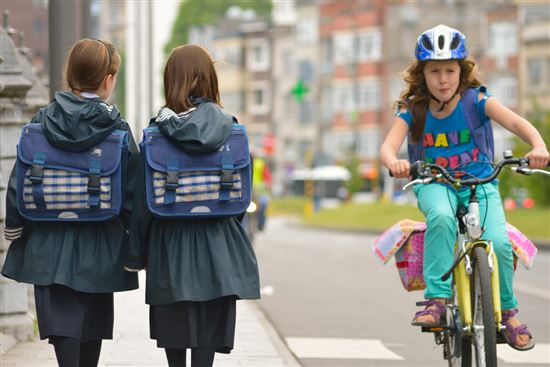School Uniform Statistics
Does school uniforms really reduce bullying, improve academic performance and make schools better? Read on for 23 thought-provoking statistics on school uniforms including how many students wear school uniforms and the cost per year.
 |
| © Jaap Joris (CC BY-SA 2.0) via Flickr |
Educators are some of the staunchest advocates of uniforms, arguing that they reduce problematic behavior, cut down on the incidence of bullying and encourage more school spirit overall. Countless research studies have attempted to pinpoint just what effect uniforms have, often with mixed results. If you're curious about how successful uniform policies are or you're wondering how the cost adds up, the CreditDonkey team has put together a list of 23 revealing tidbits that will have your brain working overtime.
School uniforms became a hot-button issue in the mid-1990s after several high-profile incidents of violence involving teens and items of clothing made headlines. Former President Bill Clinton led the charge, instructing the Department of Education to issue policy manuals to schools nationwide on how to safely institute a uniform policy. While the movement has been met with criticism by some parents and students, the practice is becoming more acceptable as schools across the country continue to jump on the bandwagon.
1. The popularity of school uniforms is on the rise
While uniforms have long been a staple of private schools, they're increasingly common in the public education realm. The percentage of public schools implementing a uniform rule jumped from 13% to 19% between the 2003-04 and the 2011-12 academic years.
2. A healthy number of schools have a uniform policy
When you run the numbers on how many schools require uniforms, it adds up to a tidy sum. There are just under 27,000 public schools and nearly 14,000 private schools that do so.
3. Not every state has warmed to the idea
Uniforms are an issue that's decided on by individual school districts, and there are many states that have opted out entirely. Currently, only 21 states and the District of Columbia have formal school uniform policies.
4. Uniforms are more common at the elementary level
Younger students are more likely to be affected by a uniform policy than their older counterparts. For the 2011-12 school year, 20% of elementary schools required uniforms compared to just 12% of high schools.
5. Income levels may influence
School districts that serve economically disadvantaged students account for the highest percentage of uniform wearers. Nearly 47% of schools where more than three-quarters of the student population receives free or reduced price lunch require uniforms.
6. Rural schools are the least likely to do so
In urban areas, nearly 40% of schools have a uniform rule in place but that's not the case with more out-of-the-way locales. Just under 9% of schools found in rural areas make uniforms mandatory.
7. The size of the school also makes a difference
In addition to geographic and economic factors, the size of a school's student body plays a part in determining whether enforcing a uniform policy is feasible. Almost 22% of schools with less than 100 students call for uniforms, versus 9.9% of schools with a total enrollment greater than 1,500.
8. Uniforms are more prevalent among private schools
Altogether, 30% of public schools have instituted some type of uniform guidelines for students. That seems like a lot until you consider that nearly 54% of private schools have similar rules in place.
9. Smaller private schools require uniforms less often
While public schools are most likely to feature uniforms when there are fewer students, private schools are just the opposite. Approximately 73% of private institutions require uniforms when there are 500 to 999 students enrolled. Only 44% do so when enrollment is below 100.
10. Uniforms don't come cheap
The back-to-school shopping rush is something most parents dread since it usually means shelling out hundreds of dollars for new clothes. When it comes to uniforms, it's not out of the question to spend anywhere from $140 to $160 to outfit your child for school.
11. Educators argue that it's still a better deal
School administrators see nothing but positives associated with the use of uniforms, starting with the financial benefit to parents. Eighty-six percent of elementary school principals believe that uniforms are more cost effective compared to purchasing regular clothing.
12. Uniform suppliers are reaping the rewards
Companies like Lands' End and French Toast are cashing in on the boom in demand for school uniforms. The industry generates roughly $1 billion in revenue each year.
13. The advantages go beyond the lower cost
Aside from the reduced expense associated with uniforms, educators agree that they offer plenty of other positives. Around 85% argue that it reduces the need for discipline in the classroom while 79% say it promotes an increased sense of student safety.
14. Kids aren't always sold on uniforms
Clothing is one way for kids to express themselves and the thought of wearing a uniform is sometimes less than welcome. A survey of Nevada students revealed that 90% of youth said they didn't like having to wear a uniform at school
15. But they do have some positive perceptions
Despite the fact that they aren't exactly thrilled about wearing uniforms, some students do recognize the benefits they offer. In the same survey, 54% of students said that having to wear a uniform didn't compromise their identity and 41% agreed that there seemed to be less gang activity at school as a result of the policy.
16. Most schools prefer a casual approach
While some schools require students to adhere to more formal uniform standards, the majority take a more relaxed view. Approximately 90% of school leaders prefer to keep things simple by requiring students to wear polos and chinos in place of dress shirts and ties.
17. But they're specific when it comes to color
The purpose of enforcing a uniform policy is to ensure that students are dressed the same, which means making sure everyone is on the same page. Ninety percent of schools require students to wear tops and bottoms that are a specific color.
18. One color sees more wear than any other
Uniforms can come in a range of hues (or even plaid), but navy blue is still the standard at 38% of schools. White is the second-most popular color, with 23% of the vote, while 15% of schools prefer students to wear red.
19. Wearing uniforms may reduce absenteeism
Missing school puts students at a disadvantage, especially if it causes them to fall behind in their studies. Research has shown that among middle and high school students, uniforms reduce absences on average by half a day each school year.
20. It can also impact graduation rates
Graduating from high school is a major milestone. Evidence suggests that requiring uniforms may increase the number of students who earn their diploma. In at least one study, the graduation rate jumped by nearly 8% after uniforms were introduced.
21. Student achievement seems to be largely unaffected
Students who wear uniforms may be more likely to make it to school each day and graduate on time, but it doesn't guarantee they'll go from making C's to the honor roll. Research has shown that math scores among middle and high school students increased by less than 0.01% after uniforms were adopted, while reading scores actually dropped by roughly the same amount.
22. Teachers are more likely to stay put
Teaching is a tough gig; roughly half a million teachers either change schools or leave the profession altogether each year. Studies show, however, that when students wear uniforms, the attrition rate drops to 5%, which is roughly 1/4 of the national mean.
23. The jury is still out on whether uniforms reduce bullying
Bullying is a pervasive problem in schools all across America, and many educators feel that uniforms reduce the potential for aggressive behavior among students. In fact, 64% of elementary school principals say that uniforms have a positive impact on bullying, despite a lack of supporting academic research.
Sources and References
Rebecca Lake is a journalist at CreditDonkey, a credit card comparison and reviews website. Write to Rebecca Lake at rebecca@creditdonkey.com. Follow us on Twitter and Facebook for our latest posts.
Note: This website is made possible through financial relationships with some of the products and services mentioned on this site. We may receive compensation if you shop through links in our content. You do not have to use our links, but you help support CreditDonkey if you do.
Read Next:




